What’s Up?
Tuesday morning was lovely with clear skies and a breeze from the east. Aside from the crane families, there was not much around. Again, one of the adults was sitting on the pretty Black-necked Stilt nest (as seen through my Leica 8×32 Trinovid HD binoculars while in my car on the South Peninsula). You know that bird photography at ILE is starting to slow down when I start looking for flowers, and that is exactly what I’ve been doing for the past few mornings …
I spent all of yesterday creating — and finally, late in the day, sending e-mail #16 for the SONY a1 Info and Updates group. The following topics were covered: Monitor and Viewfinder Display options, all Custom Key Settings, Manual Focus Magnification, and Focus Peaking. I you own or have decided to get the world’s best bird photography camera body, scroll down to learn about getting into the group. And yes, using my one of my affiliate links is the way to go as it includes a free pass into the group.
Be sure to scroll all the way down to see the final image. It is entitled, The scene of the carnage.
Today is Wednesday 9 June. The forecast for ILE is for mostly sunny with a gentle east/southeast breeze in the morning and afternoon temps in the low nineties. Accompanied by the usual high humidity. I will head down to the lake for a bit after I finish this blog post and then continue work on the Nikonians webinar slide program. Wherever you are, and whatever you are doing, I hope that you have a great day.
This blog post took about two hours to prepare, and makes 165 consecutive days with a new one. Please remember that if an item — a Delkin flash card, or a tripod head — for example, that is available from B&H and/or Bedfords and is also available in the BAA Online Store, it would be great if you opt to purchase from us. We will match any price. Please remember also to use my B&H affiliate links or to save 3% at Bedfords by using the BIRDSASART discount code at checkout. Doing either often earns you free guides and/or discounts. And doing so always earns my great appreciation.
FlexShooter Pro News
Along with the FlexShooter Pro and the FlexShooter Mini, the Levered-Clamp FlexShooter Pro is finally back in stock. Here. Tomorrow the brand new Levered-Clamp FlexShooter Mini will, by popular demand, be in the BAA Online Store. We only have six Levered-Clamp FlexShooter Minis in stock. To be sure of getting one, it would be best to order yours right now by calling Jim in the office at 863-692-0906. They will sell for $669.00. The Levered-Clamp Mini will be perfect for all mid-range telephotos and telephoto zoom lenses, and the levered-clamp is a huge improvement over the original versions with a knob.
Please Remember
With income from IPTs now close to zero, please, if you enjoy and learn from the blog, remember to use one of my two affiliate programs when purchasing new gear. Doing so just might make it possible for me to avoid having to try to get a job as a Walmart greeter and will not cost you a single penny more. And if you use Bedfords and remember to enter the BIRDSASART code at checkout, you will save 3% on every order and enjoy free second-day air shipping. In these crazy times — I am out at least forty to sixty thousand dollars so far due to COVID 19 (with lots more to come) — remembering to use my B&H link or to shop at Bedfords will help me out a ton and be greatly appreciated. Overseas folks who cannot order from the US because of import fees, duties, and taxes, are invited to help out by clicking here to leave a blog thank you gift if they see fit.
New and Better Bedfords Discount Policy!
You can now save 3% on all of your Bedfords photo gear purchases by entering the BIRDSASART coupon code at checkout. Your discount will be applied to your pre-tax total. In addition, by using the code you will get 2nd day air shipping via Fed Ex.
Grab a Nikon AF-S Teleconverter TC-14E III and save $14.99. Purchase a Canon EOS R5 and your discount will be $116.97. Purchase a Sony FE 600mm f/4 GM OSS lens and save a remarkable $389.94! Your Bedford’s purchase no longer needs to be greater than $1,000.00 for you to receive a discount. The more you spend, the more you save.
Money Saving Reminder
Many have learned that if you need a hot photo item that is out of stock at B&H and would enjoy free second-day air shipping, your best bet is to click here, place an order with Bedfords, and enter the coupon code BIRDSASART at checkout. If an item is out of stock, contact Steve Elkins via e-mail or on his cell phone at (479) 381-2592 (Central time). Be sure to mention the BIRDSASART coupon code and use it for your online order to save 3% and enjoy free 2nd-day air shipping. Steve has been great at getting folks the hot items that are out of stock at B&H and everywhere else. The wait lists at the big stores can be a year or longer for the hard to get items. Steve will surely get you your gear long before that. For the past year, he has been helping BAA Blog folks get their hands on items like the SONY a9 ii, the SONY 200-600 G OSS lens, the Canon EOS R5, the Canon RF 100-500mm lens, and the Nikon 500mm PF. Steve is personable, helpful, and eager to please.


Gear Questions and Advice
Too many folks attending BAA IPTs (remember those?) and dozens of photographers whom I see in the field and on BPN, are–out of ignorance–using the wrong gear especially when it comes to tripods and more especially, tripod heads… Please know that I am always glad to answer your gear questions via e-mail.
|
|
|
This image was created from the driver’s seat of my SUV at ILE on 6 June 2021. I used the BLUBB-mounted Sony FE 600mm f/4 GM OSS lens and The One, the Sony Alpha 1 Mirrorless digital camera. ISO 1600. Exposure determined via Zebras with ISO on the rear dial: 1/500 sec. at f/4 (wide open) in Manual mode. AWB at 7:06am on a cloudy-dark morning. Wide/AF-C was active at the moment of exposure performed perfectly by nailing and tracking the bird’s eye. Click on the image to see a larger version. Image #1: Crested Caracara with turtle egg |
Perfection?
I drove past the caracara, made a u-turn, and saw the bird with an egg in its bill. My first thoughts were that it had raided a bird’s nest and that I needed to make an image as quickly as possible. With the big lens alone (i.e., no TC) in the very low light, I placed the lens on the BLUBB on the lowered driver’s side window before approaching so that I would not flush the bird by raising the lens and sticking it out the window.
I had pre-set the shutter speed to 1/500 second and the aperture to the wide open f/4. Driving at all less than 1 mph, I stopped the car so that reflection of the tree on the other side of the canal would act as a frame on the left. I dialed the ISO up until there were lots of Zebras on the water. I acquired focus instantly; the bird seemed as curious about what I was doing as I was about what it was doing. Miraculously, it posed for an eight-frame sequence (all with a perfect head angle) before taking flight.
I followed it to the North Field and watched it enjoy its breakfast. When it was done, I got out of the car, found the small bit of egg shell, and picked it up. It was wet and leathery so I quickly realized that it was a turtle egg.
I returned to the scene of the crime. The caracara had beaten me back to the spot and proceeded to stick its head deeply into what I thought was the nest hole. The bird did not come up with another egg and flew off.
|
|
Image #1A: AF point screen capture for the Crested Caracara with turtle egg image |
FWIW
As regular readers know, I used the Canon R5 extensively for several months. For what it’s worth, I can say that the Face Detection and Bird Eye Tracking system of the Sony Alpha a1 (when set up properly) is second to none. It is interesting to note that the next Canon mirrorless body, promises less “rolling shutter” distortion during Electronic Shutter operation, still-image shooting at speeds up to 30 fps, enhanced eye detection AF that will offer new recognizable subjects for its AF system, and with Face Detect + Tracking active, a camera that will follow moving subjects around the entire active AF area. Pardon me for saying that all of that very sounds familiar to Sony Alpha a1 users …
|
|
Image #1B: Topaz DeNoise on the Crested Caracara with turtle egg image |
Low Light Amazing!
As with pretty much every image that I process, this image was run through Topaz DeNoise AI as the first step after the raw conversion. I’ve gotten to the point where I have so much confidence using Low Light on Auto for images made in low light at relatively high ISO settings, that I no longer check out the Comparison View. This saves me time. Be sure to click on the image to see the complete elimination of noise (especially in the BKGR) with no loss of fine detail in the feathers or the scutes on the caracara’s leg.
Great Topaz News!
Folks who use the BAA Topaz link to purchase Sharpen AI, DeNoise AI, or the Utility Bundle (or any other Topaz plug-ins), will receive a 15% discount by entering the ARTHUR15 code at checkout. If the stuff is on sale (as it usually is), you save 15% off of the sale price! To get the discount you must use my link and you must enter the discount code. Be sure to start with this link.
Those who purchase Sharpen AI, DeNoise AI, or any other Topaz plug-ins using my link and then entering the ARTHUR15 code at checkout can e-mail to request a short Getting Started with Topaz e-Guide. Please include a copy of your Topaz receipt that shows the discount. Aside from the basics, the guide explains how to install the plug-ins so that they appear in the Photoshop Filter Menu.
|
|
|
This image was also created from the driver’s seat of my SUV at ILE on 6 June 2021. I used the BLUBB-mounted Sony FE 600mm f/4 GM OSS lens and The One, the Sony Alpha 1 Mirrorless digital camera. ISO 1600. Exposure determined via Zebras with ISO on the rear dial: 1/640 sec. at f/4 (wide open) in Manual mode. AWB at 7:28am on a cloudy morning. Wide/AF-C was active at the moment of exposure performed perfectly by nailing and tracking the bird’s eye. Click on the image to see a larger version. Image #2: Fish Crow scavenging egg shells at predated turtle nest |
Clean-up Artist
When the caracara left, several fish crows came in to tidy up and scavenge the eggshell scraps.
Exposure Question
The light levels had increased by the time I got back but it was still plenty cloudy. Despite the similar conditions, I went with a lot more Zebras on the water for the crow image than I had for the caracara image. Why?
|
|
Image #2A: AF point screen capture for the Fish Crow scavenging egg shells at predated turtle nest image |
You-Gotta-Be-Kidding-Me Eye Detection AF
How can an AF system detect a black eye on a black head in low light conditions? Beats me, but the a1 does it consistently and easily. As long as the camera body is set up correctly and you understand how to use it.
One Amazing Thing …
One amazing thing — as explained in the a1 Info and Updates e-mails, is that the AF system of the a1 — when set up correctly, will actually detect a bird’s eye before you half-press the shutter button . And to think that I’d always dreamed of science-fiction-like autofocus …
Sony Alpha a1 AF
Barring operator error, the performance of the Sony Alpha a1 AF system at any focal length — including 1200mm as seen in recent blog posts — is, when the a1 is set up properly as detailed in the in e-mails to the Sony Alpha a1 Info & Updates group, more than remarkable. Early on, there was lots of discussion within the group with many preferring multiple back button approaches. For me a simple shutter button approach with the right AF settings that yield 99% sharp-on-the-eye images is best. By far. It is super-simple and mega-effective. In the next SONY Alpha a1 Set-up and Info Group e-mail, I will be sharing what I have learned as to when and in what situations it is best to abandon Wide. And with what. The group has already learned to limit the AF Area choices and to switch AF Areas quickly and conveniently. The default method of switching AF points with the C2 button is both slow and cumbersome.
SONY Alpha a1 Set-up and Info Group
The SONY Alpha a1 Set-up and Info Group is going great guns as folks chime in with thoughtful questions and experience-based advice. We are now up to an astounding 46 lucky folks. Early on, we discussed the myriad AF options. I gave my opinion as to the best one for flight and general bird photography. More recently, we have been in contact with folks at SONY sharing our thoughts, experiences, and frustrations with the EVF blackout problem.
All who purchased their Alpha a1 bodies via a BAA affiliate link will receive a free subscription to the Sony Alpha a1 Set-Up and Info Updates after shooting me their receipts via e-mail. (Note: it may take me several days to confirm B&H orders.) This same service may be purchased by anyone with an a1 body via a $150.00 PayPal sent to birdsasart@verizon.net indicating payment for Alpha a1 Info Updates. Alternatively, folks can call Jim weekdays at 1-863-692-0906 to pay via credit card. New members will receive composite e-mails that summarize all previous discussions.
|
|
|
This image was created on 6 June 2021 at ILE. I used the hand held Sony FE 24-105mm f/4 lens at 24mm and The One, the Sony Alpha 1 Mirrorless Digital Camera (Body Only). AUTO ISO 800. The exposure was determined by Zebras with ISO on the rear wheel: 1/60 sec. at f/8 (stopped down to stops) in Manual mode. AWB at 7:34am with on a cloudy morning. Tracking: Expand Spot/AF-C was active at the moment of exposure and performed perfectly. Click on the image to enjoy a larger version Image #3: The scene of the carnage |
The Scene of the Carnage
When I got out of the car to view the scene of the carnage, I wondered if the circular hole, about two inches in diameter and at least six to eight inches deep, was a result of the turtle nest hatching. So I called BAA Blog turtle expert Matthew Milnes, a biology professor who has spent most of his career studying the physiology of reptiles. He grew up in FL. His response opened my eyes: “The hole is the classic sign of predation by a ground mammal such as a raccoon, an opossum, a fox, or a skunk.” As I have never seen (or smelled a road-killed) skunk here at ILE, it is likely that the nest was predated in the dark by one of the other three — probably by a raccoon as they are very common here. Once it began to get light, the birds flew in to join in the feast. I got in on the show at the tail end of things.
Noting the large numbers of eggshells scattered about, Matt thinks that this nest was likely from a Peninsular Cooter, a Common Snapping Turtle, or a Florida Soft-shelled Turtle. As I have said here before the breadth of the knowledge of folks here on the blog and their willingness to share it is staggering. Thanks again, Matt!
Typos
With all blog posts, feel free to e-mail or to leave a comment regarding any typos or errors.


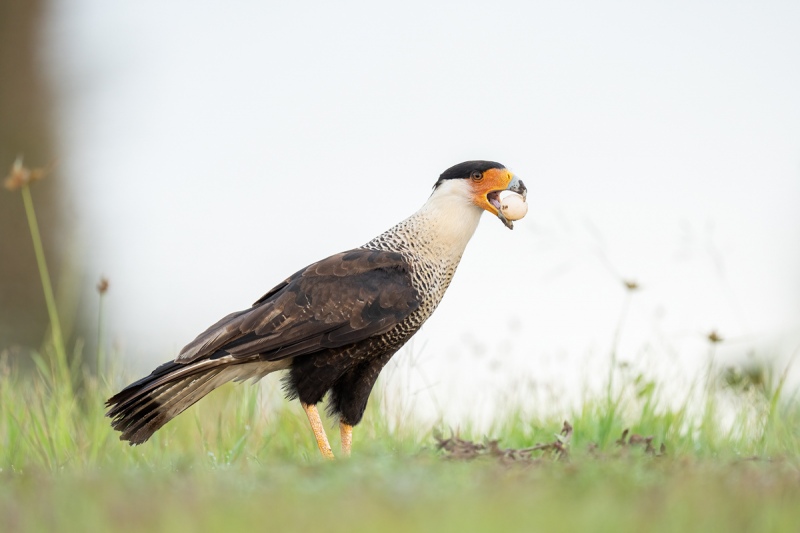
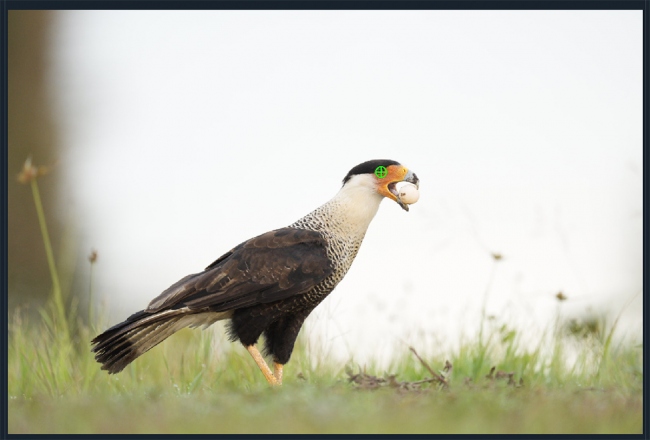
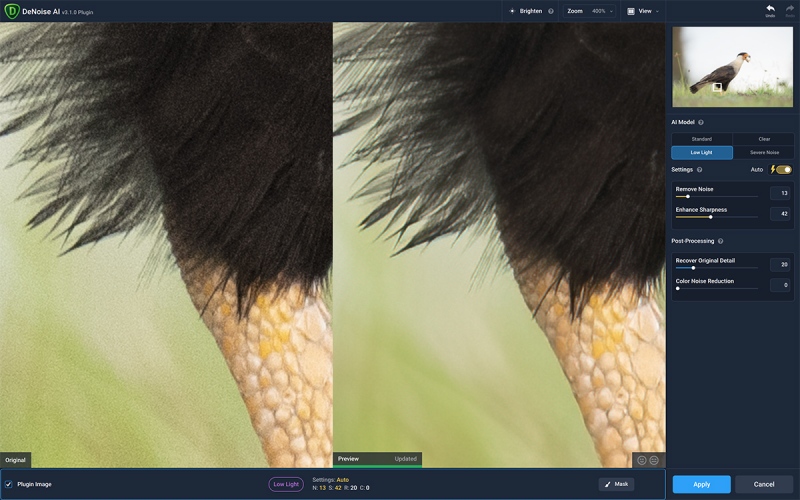
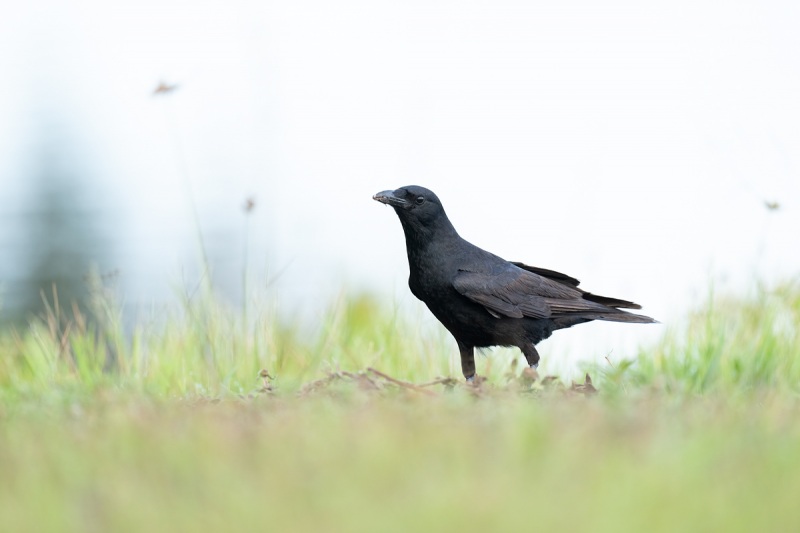

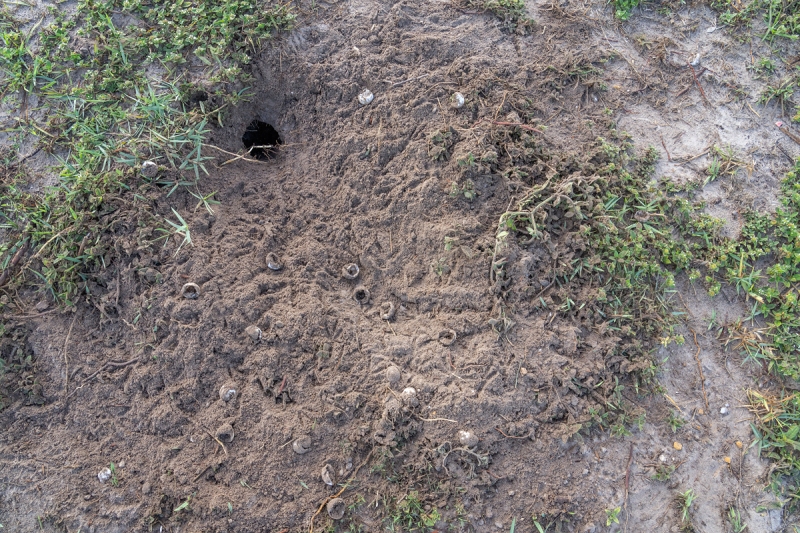













Howdy Artie
Wow that is really sweet and how many pictures have you got in your years of any birds with eggs. Today in Wisconsin I came across a snapper heading inland to lay her eggs as here they lay in June and Hatch near October. Would have been really nice to have seen where she laid the eggs so I could have marked the spot. I did that a few years back and actually did catch the hatch and I counted 49 little snappers that was cool.
Always with love b
You were a very lucky man.
with love, artie
I’m so glad you posted the caracara with the turtle’s egg — I had been looking forward to that. It didn’t disappoint!
Your wish …
with love, artie
Hi Artie,
Typo? “Matthew Milnes, a biology professor who has spent most of my career studying the physiology of reptiles.” s/b “his career”?
Hey Jordan,
Good catch. Thanks for keeping me on my toes. Again 🙂
with love, artie
Number 1 and 4 and 5 are great and interesting! 1 and 4 are really cute also! And especially 1 with Munch Munch!!